Birmingham Central Tramways
History
The Birmingham Central Tramways Company, which started life in late 1882 as the Birmingham Suburban Tramways Company, operated horse, steam, battery and cable-hauled tramway services over its decade-long existence.
Its first service, which was horse drawn, ran on the 11th November 1884 over the corporation-owned 3ft 6ins-gauge line from Albert Street in the centre of Birmingham northeastwards to Nechells. The first steam service was introduced two weeks later on the 24th November over the corporation-owned route northwards to Perry Barr, with route mileage expanding greatly over the next two years, mostly via corporation leases, the latter having decided relatively early on to control all tramway development within its boundaries by building its own lines and leasing them to tramway operators.
On the 1st January 1886, the BCTCo purchased the assets of the standard-gauge Birmingham Tramways and Omnibus Company Ltd, and at the same time, took over the lease of the corporation tracks formerly worked by the BT&OCo (Colmore Row to Hockley Brook). The latter line was converted to cable operation by the Patent Cable Tramways Corporation, with the first service — operated by the BCTCo — running on the 24th March 1888; it was later extended as far as New Inns in Handsworth (on the 20th April 1889). The line was not, however, the success that had been hoped for, so instead of cable traction, the mainly corporation-owned Bristol Rd line was regauged to 3ft 6ins and switched from horse to battery electric traction, the first service running on the 24th July 1890. The company was, however, now locked into a host of leases, and was operating four types of traction, a situation that could hardly be described as efficient.
The BCTCo was taken over on the 29th September 1896 by the City of Birmingham Tramways Co Ltd, whose intention was to convert all the routes to overhead electric traction.
At its zenith, the BCTCo operated around 26 miles of tramway, the vast majority of it leased from Birmingham Corporation. The system comprised lines: northwards to Perry Barr; northeastwards to Nechells and Saltley; eastwards to Small Heath; southeastwards to Spark Hill; southwards to Kings Heath; southwestwards to Bournbrook; and northwestwards to Handsworth and Lozells.
Uniforms
Although photographs showing staff of the horse, battery and cable operations are rarer than those of its successor, the CofBTCo, enough have survived to confirm that crews were not provided with uniforms.
In common with the majority of steam-operated tramways, BCTCo steam-tram drivers wore very similar attire to their railway counterparts, namely, heavy cotton trousers and jackets, often light in colour, along with bowler hats or soft-topped peaked caps. No badges or insignia were worn on either the jackets or the caps. Conductors wore a variety of jackets, strongly suggesting that they were self-purchased rather than company issued; a variety of headgear was also worn, predominantly bowler hats and soft-topped peaked caps, once again suggesting that this was the preserve of the individual rather than the company. No badges were worn on either the jackets or the caps/hats.
Conductors on all services (horse, steam, battery and cable) wore round municipal licence badges; these bore a number and a grade ('CONDUCTOR'), above which were the arms of Birmingham. There were two types of licence badge, reflecting the situation prior to, and after the elevation of Birmingham to city status and the grant of arms in April 1889 (see below). Whilst horse, battery and cable tram drivers wore licence badges, their steam tram counterparts did not.
A single photograph has survived — taken in the mid-to-late 1880s — that shows an inspector. He is wearing a single-breasted, three-quarter length coat, edged in a finer material than the main body, probably closed with hook and eye fasteners, and with stand-up collars; the latter bore badges on both sides, more than likely his grade — 'Inspector' — in embroidered script lettering. His headgear took the form of a tall, drooping-peak cap, topped with a pom pom, and bearing a badge (of unknown description).
Further reading
For more information on the Birmingham Central Tramways, see: 'A History of the British Steam Tram — Volumes 1 and 2' by David Gladwin; Adam Gordon Publishing (2004 and 2006). For a history of Birmingham's tramways, see: 'A Short Review of Birmingham Corporation Tramways' by P L Hardy and P Jaques; H J Publications (1971).
Images
Steam tram drivers and conductors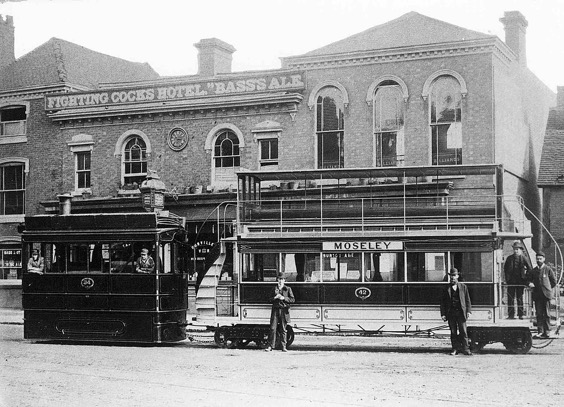
Steam Tram No 34 and Trailer No 42, both Falcon products of 1885 stand outside the Fighting Cocks Hotel in Moseley — photo undated, but judging by the excellent condition of the vehicles, probably taken in 1885 or 1886. Photo courtesy of David Gladwin, with thanks to Trevor Preece.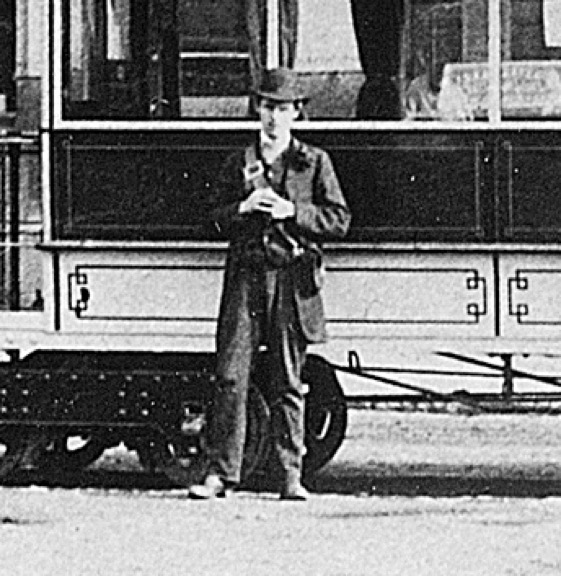
An enlargement of the above photograph showing the conductor. He is wearing informal attire comprising a frock-style coat and a tall bowler with curved brim.
A shot of Steam Tram No 41 (a Falcon product of 1885), at what is probably Kingsheath depot — photo undated, but certainly taken early in the vehicle's life, so 1885 or 1886. The driver is wearing a pristine jacket, along with a bowler hat with upturned brim typical of the mid-to-late 1880s.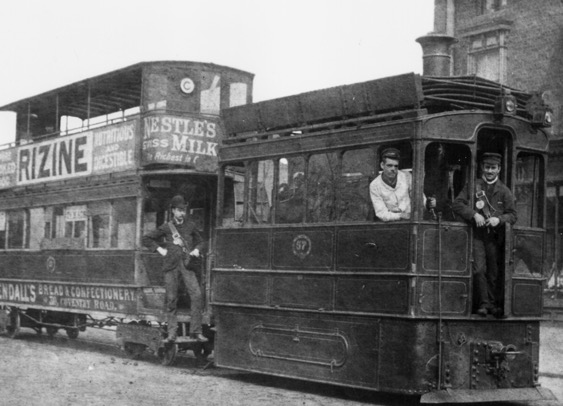
Two conductors and a driver pose for the camera with Falcon-built Steam Tram No 57 (of 1884) on a Route C working (to Coventry Road) — photo undated, but probably taken in the late 1880s (No 57 was obtained second hand from Hartlepool in 1886). Photo courtesy of the Tramways and Light Railway Society, with thanks to David Voice.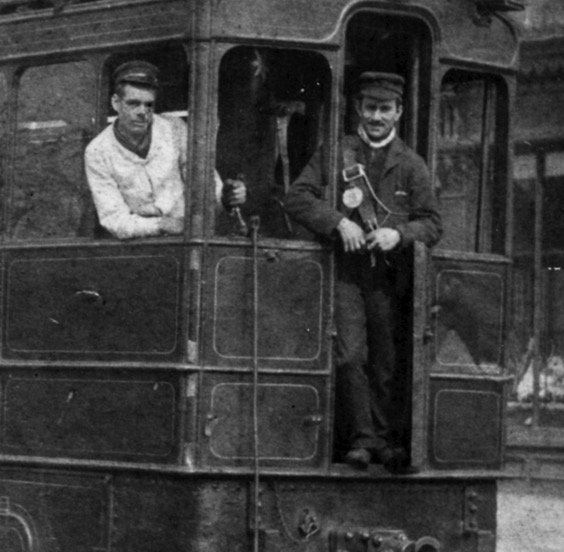
An enlargement of the above photograph showing the conductor and the driver. The conductor is not wearing a uniform, the only insignia being a licence badge, probably the same pattern as that shown below.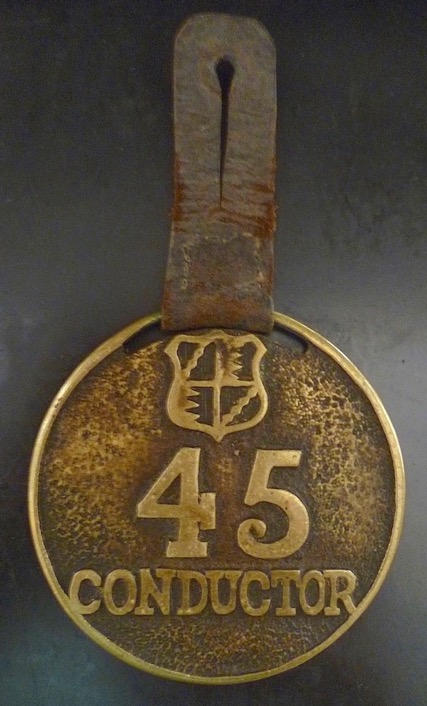
Birmingham municipal licence badge — brass — of the pattern probably issued to BCTCo conductors prior to 1889. In April 1889. a full grant of arms was made to the city, including supporters and crest. Author's Collection.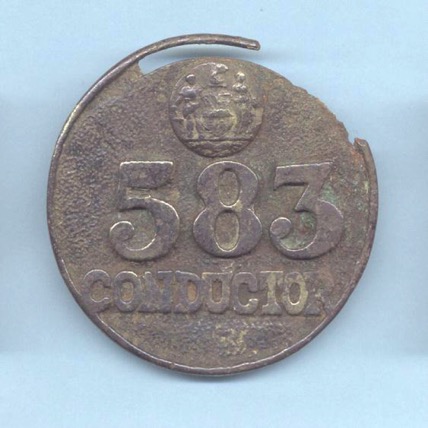
Birmingham municipal licence badge — brass — of the type probably issued to BCTCo conductors from 1889 onwards, following the full grant of arms to the new city.
Birmingham municipal licence badges, pre-1889 (top) and 1889 onwards (bottom) — brass. This oval pattern of licence badge may well have been used at some point, though photographic evidence for this is completely lacking. Author's Collection.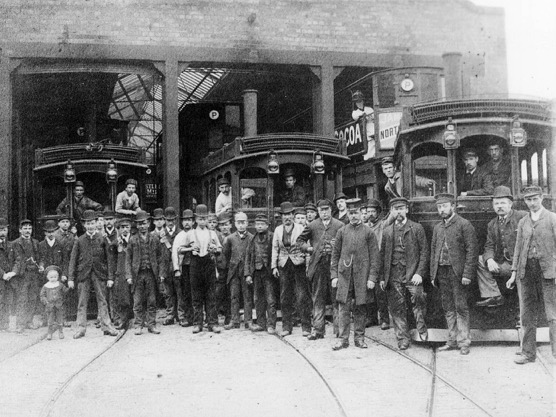
An excellent photo of an array of BCTCo staff outside what is thought to be the depot at Perry Barr — photo undated, but probably taken in the mid-to-late 1880s judging by the headwear. The sole uniformed figure, centre right, is almost certainly an inspector. Photo courtesy of David Gladwin, with thanks to Trevor Preece.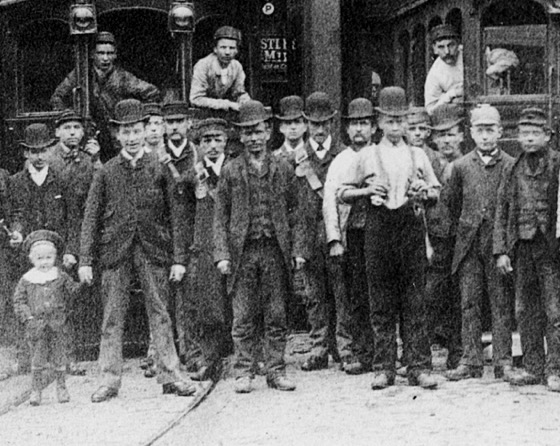
An enlargement of the above photograph showing some of the men, including two conductors with their cash-bag straps and round licence badges. Most of the assembled men are wearing the tall bowler hats of the period, whilst others favour a variety of soft-topped peaked caps, none of them official issues.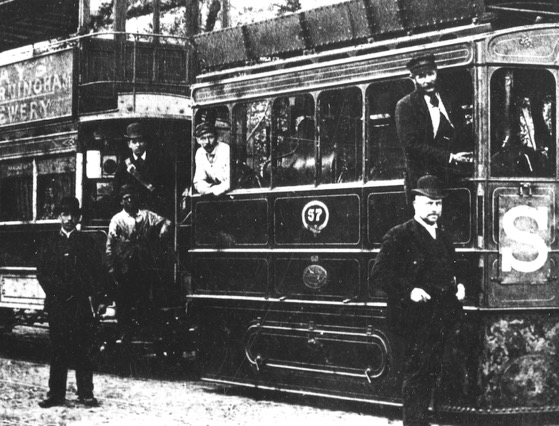
Another photograph of No 57 working the Sparkbrook route — photo undated, but probably taken in the late 1880s or early 1890s. All present are in informal attire, with the possible exception of the figure on the left, who may be wearing some form of collar insignia. Author's Collection.
Cable tram drivers and conductors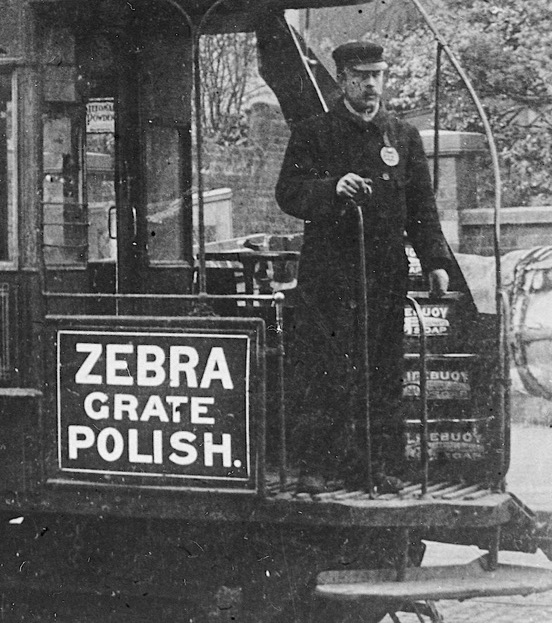
BCTCo driver aboard Cable Tram No 79 with a service for New Inns — photo dated 1896. Although he is clearly wearing a municipal licence badge, the rest of his uniform is completely devoid of insignia. Photo courtesy of the National Tramway Museum.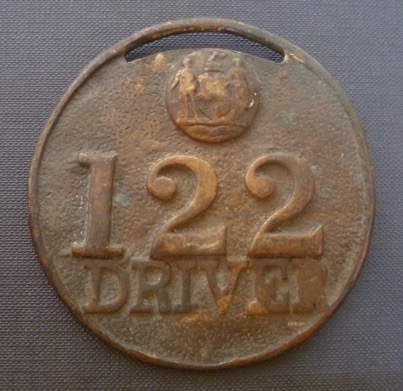
Birmingham municipal driver's licence badge (No 122) — brass — of the type issued to BCTCo horse and cable tram drivers from 1889 onwards (and battery trams drivers from 1890), following the full grant of arms to the new city. Author's Collection.
Senior staff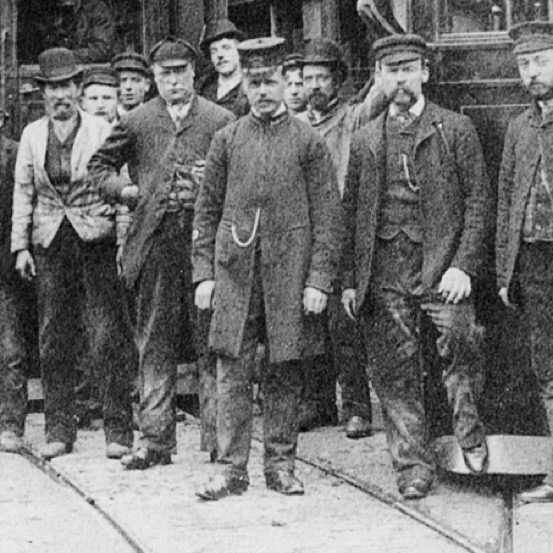
An enlargement of the late-1880s Perry Barr depot photograph above, showing the inspector. He is wearing a three-quarter length jacket with stand-up collars bearing badges of some description, more than likely his grade — 'Inspector' — in embroidered script lettering. His tall drooping-peak cap bears a pom pom and a cap badge (of unknown pattern).